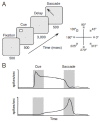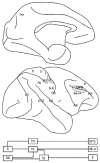The primate working memory networks
- PMID: 15849890
- PMCID: PMC3885185
- DOI: 10.3758/cabn.4.4.444
The primate working memory networks
Abstract
Working memory has long been associated with the prefrontal cortex, since damage to this brain area can critically impair the ability to maintain and update mnemonic information. Anatomical and physiological evidence suggests, however, that the prefrontal cortex is part of a broader network of interconnected brain areas involved in working memory. These include the parietal and temporal association areas of the cerebral cortex, cingulate and limbic areas, and subcortical structures such as the mediodorsal thalamus and the basal ganglia. Neurophysiological studies in primates confirm the involvement of areas beyond the frontal lobe and illustrate that working memory involves parallel, distributed neuronal networks. In this article, we review the current understanding of the anatomical organization of networks mediating working memory and the neural correlates of memory manifested in each of their nodes. The neural mechanisms of memory maintenance and the integrative role of the prefrontal cortex are also discussed.
Figures







References
-
- Akkal D, Bioulac B, Audin J, Burbaud P. Comparison of neuronal activity in the rostral supplementary and cingulate motor areas during a task with cognitive and motor demands. European Journal of Neuroscience. 2002;15:887–904. - PubMed
-
- Alexander GE, DeLong MR, Strick PL. Parallel organization of functionally segregated circuits linking basal ganglia and cortex. Annual Review of Neuroscience. 1986;9:357–381. - PubMed
-
- Amador N, Schlag-Rey M, Schlag J. Reward-predicting and reward-detecting neuronal activity in the primate supplementary eye field. Journal of Neurophysiology. 2000;84(4):2166–2170. - PubMed
-
- Andersen RA, Essick GK, Siegel RM. Encoding of spatial location by posterior parietal neurons. Science. 1985;230(4724):456–458. - PubMed
-
- Andersen RA, Essick GK, Siegel RM. Neurons of area 7 activated by both visual stimuli and oculomotor behavior. Experimental Brain Research. 1987;67(2):316–322. - PubMed
Publication types
MeSH terms
LinkOut - more resources
Full Text Sources
Medical
